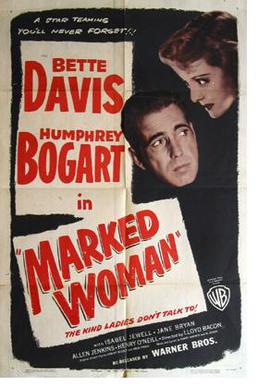Click on the headline to link to a Wikipedia entry for the 1930s social drama Marked Woman.
DVD Review
Marked Woman, starring Bette Davis, Humphrey Bogart, Warner Brothers, 1937
You know sometimes the distance between a femme fatale and just an ordinary working woman down on her uppers is very slight, very slight indeed. So, say Frank never showed up at that ocean front diner out in California to watch Cora come through that back of the house door to the dining area in The Postman Always Rings Twice and seal his fate (and hers) as they dashed through every kind of murderous impulse and savage passion. Femme Cora would probably still be serving them off the arm, still be listening to Nick’s grousing, and maybe growing old gracelessly down by the seashore, Or, say, Robert Mitchum had actually done what he was paid to do in Out Of The Past and turned the errant femme Jane Greer over to Kirk Douglas for retribution instead of dashing through every kind of murderous impulse and savage passion with her. Dear Jane might still be sunning herself and drinking high-shelf drinks in some cabana and rattling around some big old hacienda. Or, finally, what if Irish Blackie had just turned the other corner and not been almost knocked over by that horse-driven carriage carrying on Rita Hayworth in The Lady From Shang-hai instead of dashing through every kind of, what, oh yes, every kind of murderous impulse and savage passion with her. Maybe, just maybe, Rita would have grown old weaving baskets or watching sub-titled films while passing the time at some high-end opium den. See for the femmes it is always a close thing, a very close thing.
So imagine how close that margin is when just an average girl, an average working class girl down on her uppers but loathe to spend her life in seven to three six day shift factories , just trying to do, well, do the best she can. That bit of social reality, that 1930s bit of social reality, is the theme behind the film under review, Warner Brothers’ Marked Woman (from the period when that studio was well-known for producing such socially significant drama). See, if you were (are) a sugar daddy “kept” woman then you have your well-honed femme charms to see you through. But say you are some Mary (yes, Mary will do as a name just fine for this point), not bad for looks, but just a little too world-wise, a little too jaded, just a little too smart, and just a little too un-femme to have the Mayfair swells lined up at your door. Then you either serve them off the arm, swab a mop, or tend some ungodly machine, unless of course you decide, as our film Mary did (played by Bette Davis, the girl with the, uh, Bette Davis eyes) to become a “hostess” at one of Johnny Vanning’s hot spot New York night clubs and “clip” the customers for drinks and dimes. And that was our Mary’s choice; she decided that she would see that career path through to “easy street” come hell or high water.
Of course this hostess dodge is just a polite way to say working girl (non-factory),whore or prostitute so let’s not fall into dreamland about what was expected, expected when master gangster Johnny Vanning took over the New York clubs and was determined to create more huge profit centers to add to his enterprises. Not if you wanted to stay above water, literally. But as the story unfolds the difference between that water and living to tell the tale was a near thing. See Mary had things figured out, or thought she did, her and her four other hostess roommates who were sharing a place to cut down on expenses in high-priced New York. Of course she didn’t count on two things to mess up her easy street plans -one that a “mark” she had set up for Johnny ‘s gambling tables was not able to pay his gambling debts, not even close, and therefore wound up rather dead for his mistake. Mary, as an accomplice of Johnny’s on this caper, threw the hammer-headed crusading District Attorney (played against type a bit by Humphrey Bogart then known mainly for the Duke Mantee gangster on the lam role in the also Betty Davis- starring Petrified Forest) a fast ball and Johnny walked, walked free as a bird and Mary thumbed her smart nose at old John Law.
The second thing was more serious, involving her visiting kid sister who got caught up in the dragnet around Johnny’s trial, and around knowledge of her sister’s real livelihood (a livelihood keeping sis in pencils and books at old something U) and decided she could not go back to college. On a fling she attended one of Johnny’s parties and wound up very dead for her troubles after she caught on that she was not really the hostess type and ran afoul of Johnny’s wrath. Mary, finally catching on that she was in a no win situation working in gangland, although only finally catching on after she took a merciless beating from Johnny’s boys, decided to play ball with the law for real this time. Naturally Johnny had to go down on that sister rap and he and his boys were convicted on the testimony of Mary and her other hostess friends. DA Humphrey got his glory and big headlines but what did Mary and the other women get? No question, being a working girl, working those mean streets and hard on the shoe leather clip joints then wasn’t exactly the road to easy street, no way. The streets were not for dreaming then. Now either come think of it.

